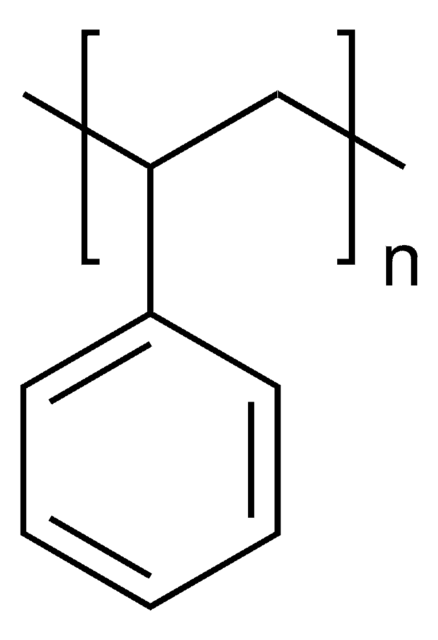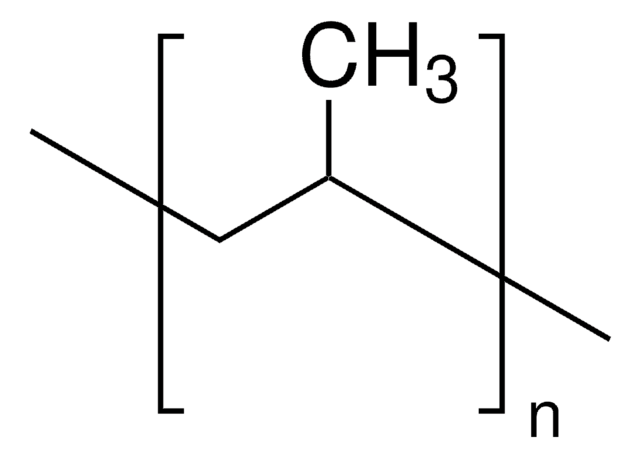450383
Polystyrene
average Mw ~400,000 by GPC
Synonym(e):
PS
Anmeldenzur Ansicht organisationsspezifischer und vertraglich vereinbarter Preise
Alle Fotos(1)
About This Item
Lineare Formel:
[CH2CH(C6H5)]n
CAS-Nummer:
MDL-Nummer:
UNSPSC-Code:
12162002
PubChem Substanz-ID:
NACRES:
NA.23
Empfohlene Produkte
Form
powder
Mol-Gew.
average Mw ~400,000 by GPC
mp (Schmelzpunkt)
212 °C
InChI
1S/C8H8/c1-2-8-6-4-3-5-7-8/h2-7H,1H2
InChIKey
PPBRXRYQALVLMV-UHFFFAOYSA-N
Suchen Sie nach ähnlichen Produkten? Aufrufen Leitfaden zum Produktvergleich
Anwendung
- Applications of Polystyrene in Industrial Chemistry: This comprehensive review discusses the synthesis, characteristics, and wide-ranging applications of polystyrene, emphasizing its role in academic research and industrial usage (T Arfin et al., 2015).
- Upcycling Polystyrene: This article explores innovative approaches to recycling polystyrene, reducing environmental impact and advancing sustainability in material sciences (JC Capricho et al., 2022).
- Potential Toxicity of Polystyrene Microplastic Particles: Examines the potential impacts of polystyrene microplastics on human health at the cellular level, important for public health and safety (J Hwang et al., 2020).
Physikalische Form
90% isotactic.
Lagerklassenschlüssel
11 - Combustible Solids
WGK
WGK 3
Flammpunkt (°F)
Not applicable
Flammpunkt (°C)
Not applicable
Persönliche Schutzausrüstung
Eyeshields, Gloves, type N95 (US)
Hier finden Sie alle aktuellen Versionen:
Besitzen Sie dieses Produkt bereits?
In der Dokumentenbibliothek finden Sie die Dokumentation zu den Produkten, die Sie kürzlich erworben haben.
Kunden haben sich ebenfalls angesehen
Prasert Akkaramongkolporn et al.
AAPS PharmSciTech, 10(2), 641-648 (2009-05-20)
The differently sulfonated styrene-divinylbenzene cross-linked copolymer cationic exchange resins were prepared by oil-in-water polymerization and varied degrees of sulfonation. Several characteristics of the obtained resins were evaluated, i.e., Fourier transform infrared spectra, the ion-exchange capacity, microscopic morphology, size, and swelling.
Hui Xia et al.
Journal of colloid and interface science, 376(1), 322-326 (2012-03-27)
The aggregation kinetics of particles in dense polystyrene latex suspensions is studied by low-coherence fiber optic dynamic light scattering. Low-coherence fiber optic dynamic light scattering is used to measure the hydrodynamic radius of the aggregates. The aggregation kinetics data obtained
Liang Zhang et al.
Journal of colloid and interface science, 353(2), 557-561 (2010-10-30)
Reported are adsorption isotherms for guar and hydroxypropyl guar (HPG), with and without the presence of borate ions, onto surfactant free anionic polystyrene latex. Guar and HPG formed adsorbed monolayers on the hydrophobic latex. The presence of borate ions converted
Katherine Sarlo et al.
Toxicology, 263(2-3), 117-126 (2009-07-21)
Understanding tissue distribution and clearance of nanomaterials following different routes of exposure is needed for risk assessment. F344 female rats received single or multiple exposures to 20 nm, 100 nm or 1000 nm latex fluorospheres by intravenous (i.v.) injection or
Di Wei et al.
ACS nano, 2(12), 2526-2530 (2009-02-12)
We have fabricated single-walled carbon nanotube (SWNT) field effect transistors (FETs) with molybdenum source and drain contacts. Normally, these devices operate only as p-channel transistors, however, after polystyrene latex nanospheres were attached to the nanotubes close to the contacts, they
Artikel
Universal Platform for Surface Modification Employing Grafted Polymer Layers
Unser Team von Wissenschaftlern verfügt über Erfahrung in allen Forschungsbereichen einschließlich Life Science, Materialwissenschaften, chemischer Synthese, Chromatographie, Analytik und vielen mehr..
Setzen Sie sich mit dem technischen Dienst in Verbindung.



